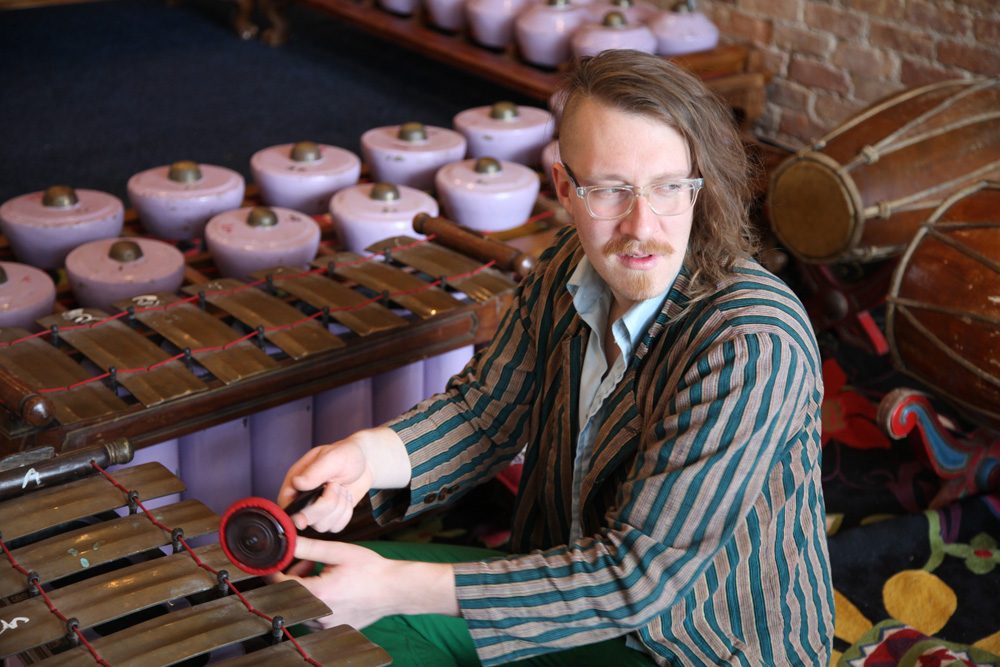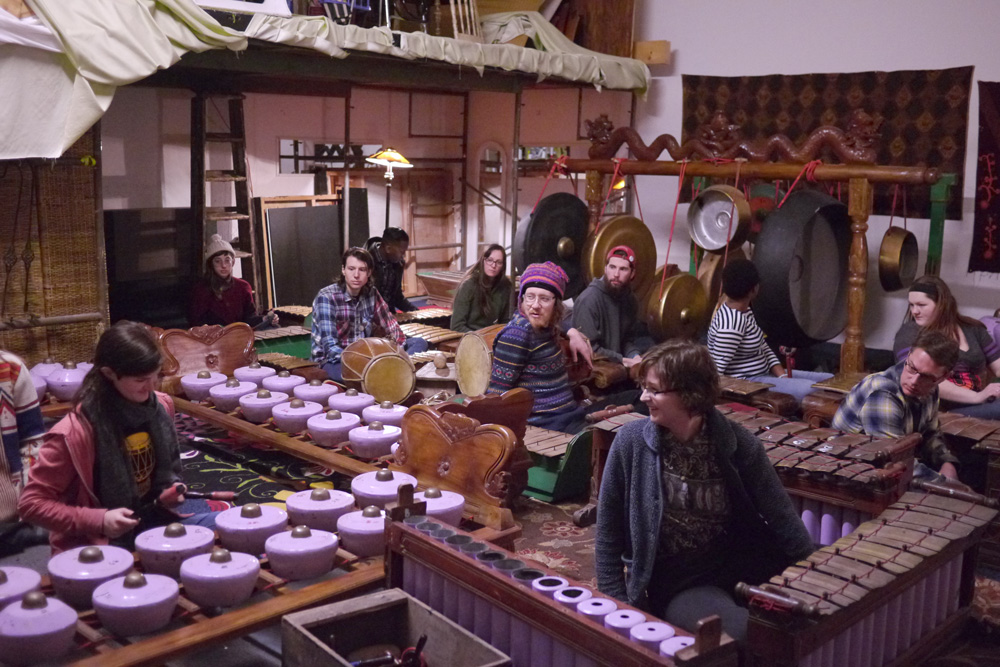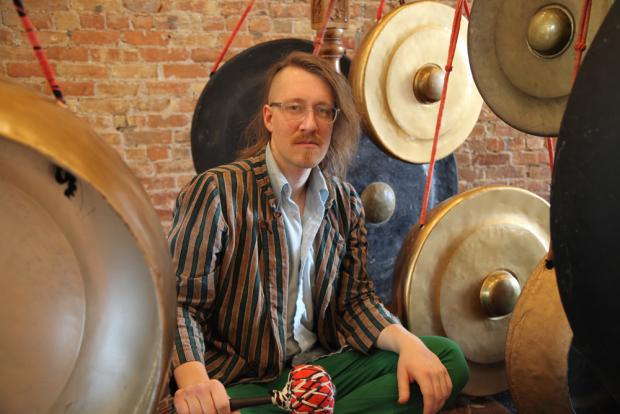Spotlight: Buffalo Gamelan Club Is Looking for a Home
After years of practicing and learning about Indonesian gamelan music at Fredonia State University, in the city of Chicago, and on the island of Java in Indonesia, musician Matt Dunning found himself in a predicament. Gamelan is a percussive style of music that is played with an ensemble of players on a wide range of instruments, such as gongs and wooden xylophone-type instruments called gambangs. Dunning aquired a fairly large set of instruments while learning under the tutulege of a gamelan master in Java. When he left Java a couple of years ago he was forced to leave behind the instruments, which include gongs that measure about three feet in diameter. Now, he’s been reunited with his instruments and has found a temporary home for them at 1526 Main Street, where he teaches a community gamelan class each Tuesday night. But he needs a permanent home for his impressive collection.
Angelo Ashker, who rents the space at 1526 Main Street, agreed to allow Dunning to use his space after Dunning suddenly found himself without a place to store the instruments.
“I’m always up for an adventure and this sounded like one,” says Ashker, who also rents the space for tango classes, paint classes, and to The Public for office space. “We had space here so I thought we could play a role in providing a safe spot for it. I’m also always interested in meeting some new friends. Being in this spot, where you have some traffic going by and some other activity, I thought maybe as people learn about it and see it, it would increase the awareness about it and maybe the right door would open up for more of a permanent home.”

Ashker plans to begin transforming the space on Main Street into a cafe next month, in accordance with his original plans. For now the space acts as a sort of makeshift cultural hub for the neighborhood.
“It’s definitely been something that has evolved as we’ve realized the needs of the community,” says Ashker. “We’ve been here for some time, just trying to catch that pulse—what’s needed and what’s wanted. That was kind of the goal, to serve the community in a way that is needed and can affect positive change.”
“That is so in tune to how things work in Java,” says Dunning. “Everything is together. There’s not a place for this and a place for this. Life just happens.”
The urgency to find a permanent space for the instruments is real, though, and he hopes that he’ll find the right home by teaching the community about what gamelan is.
“We’d love to work with organizations or people who are community-minded and who are really interested in being a part of something that is so interesting culturally. It has the potential to bring people together and provide access to things that normally people would not consider doing. Somebody who has that sort of idea in mind is somebody we’d love to work with, but really we’d love to work with anybody who could help us out with a space,” he says, laughing.
From 7pm to 10pm on Friday, April 1, Dunning and Ashker will hold an open house at 1526 Main for those interested in learning about gamelan music and for those who might be of assistance in finding a permanent home for the instruments. There will be a demonstration by current students of the Buffalo Gamelan Club, followed by an open demo for anyone who would like to play the instruments.

This week we talked to Dunning about gamelan music, how he transported his instruments to Buffalo, and why first-time musicians should be interested in this unique style of music.
How did you get into gamelan music? The first time I’d heard of gamelan was at Fredonia. I used to skip this class a lot but I didn’t skip it this day; it was a world music class at eight in the morning. We talked a lot about Peruvian flutes most of the time, but he talked about this kind of music for like five minutes one day and I was just, like, “Whoa.” I knew that it was something that I wanted to get involved in. It’s the unique sound of it, the cyclical structure of it. It drew me into it instantly. I grew up playing the French horn in orchestras and I always disliked it. I knew it wasn’t for me. So when I heard this I was like—that’s something I can totally get behind. After college I moved to Chicago and lived there for seven years, and there’s a group there—a community group kind of like what we’re trying to do here—that I played with. Then I got a residency scholarship from the Indonesian government to go to Indonesia to play. It was a one-year program and I got it two years in a row, 2011 and 2013.
So you went to Indonesia specifically to study this? Yeah. I went there because I liked the music; I’d been playing it for a while and I really wanted to learn more. My music group in Chicago was just Americans—no Javanese, no Indonesians in the group. It always felt like there was something missing from the group. I felt like I needed to learn this music from the people who made it. So I went over there expecting to learn a lot about music but I learned a lot about a lot of stuff. It’s not just the music, it’s the culture. They’re one in the same. Playing music, singing, being involved in art, having art everywhere, that’s what the culture is like there.. Even if they’re not musicians, your neighbor might be a random graphic designer, your other neighbor might be building random gadgets. There are a lot of talented people in general. I was taken by a lot of things over there and I was confronted by a lot of things over there and all of it leads back to the music.
What was your experience like arriving in Java? It was difficult. I got this program and I didn’t know any Indonesian. The city where I lived, the language is Javanese, which is a very old and complicated language. They don’t really encourage you to learn Javanese, they encourage you to learn Indonesian, but nobody speaks Indonesian so you can’t even hear it to understand what it sounds like. There are 200-some languages. Everyone understands Indonesian but many people speak their own dialect. TVs and newspapers are in Indonesian. What’s on TV and what people speak are completely different languages for all intents and purposes.
What were your classes like in Java? I was originally put at a performing arts school where I could take classes. I met some good teachers but I didn’t really jell with the structure of the classes. I got private teachers who were from royal palaces or people from little villages who were just like generations of musicians. The way I would learn is I would go to one of my teacher’s houses and I’d hang out with them for like six or seven hours. The music is all an aural tradition. There is sheet music but it doesn’t tell you the whole story. The sheet music will give you the basic information applicable to two or three instruments. All of the other instruments have to sort of derive their parts from skills of the player. So you have to know how to play your instrument in order to read the sheet music and interpret it. The way it works is you learn all of these different tools and as a player—this is why it’s players music—you can kind of choose how to play the piece. Every single gamelan player has a different interpretation of what this song might sound like and how to play it. Everybody has their own styles, and this is another complicated thing about learning because you can go from one teacher to another and they can have such different ideas about what you should be doing that it’s like starting over. It’s a stylistic thing. You can learn a lot of different styles but you can’t play those styles in front of your other teachers or else they’re going to be like “where did you learn that?” It’s almost like a betrayal.
Was it easy to become integrated into the community? When I first moved to Java I had to find somewhere to live. The government just dropped me off in this city and said go nuts, find somewhere to stay. You’re on your own. Through some random online searches I found this guy who drove me all over the city and I found a house to rent. I kept hearing from my neighbors that there was some kind of master musician who lived in my neighborhood but nobody would tell me who he was or when he played. They had this community gathering called a Klengenan and I was finally able to meet this master player. He was the last player in his family, nobody else learned how to play this stuff, they were all rock musicians, rappers, artists, all kinds of other art but not this stuff. He died while I was over there about half way through my time there. His family was selling his stuff.
So these are the master’s instruments? Half of them are, half of them I got from a different master. I cobbled them together. Some of them are new instruments that were built by another teacher of mine. After he died we moved all of the stuff to my house in Indonesia, so then all of the village people would come over to my house and we’d have these little music jams.
How much did the first set of instruments cost you? The original set of instruments cost me a motorbike. I bought a motorbike from this family and I rode it for a while and I traded it back to them and they gave me the instruments.
How did you get this stuff from Java to Buffalo? I left Indonesia two or three years ago. I had all of this stuff there and I didn’t know what to do with it. I had some Hungarian friends who were still there and they were kind of watching this stuff but they left. So the stuff was kind of just sitting there for a while. For two years this set was used as kind of a community set and was stored in an outdoor structure called a pendopo. The shipping for this stuff probably cost about $7,000. I couldn’t pay for it, it was impossible, so actually, and I don’t know how I did this, but the Indonesian embassy in Washington, DC paid for the shipping to Buffalo. It came over on a big boat. That was in November.
What did you do with the instruments once they arrived in Buffalo? We were fortunate to get some space at Hi-Temp Fabrications, where we stored this stuff for a couple of months. Then we were at the Alt Theater but we were only there for a month. Then Angelo came to the rescue and hooked us up with this spot here and that’s where we’ve been ever since.
Tell me a little bit more about the style of gamelan music. The music isn’t linear, it’s cylclical. You kind of enter into a piece and there isn’t really a start or a stop. It just happens and you evolve and rotate and go through phases in the music. We’re just playing beginner stuff now but pieces can run up to 30 or 40 minutes long. The instruments we have here are made out of iron and brass. This is not a fancy set of gamelan. This is your village set of gamelan. A fancy set would be made out of bronze and probably cost 10 times as much.
What types of instruments do you have in your collection? There are big gongs, also known as kampul. Kanongs are more structural, time-keeping instruments. The bonang are elaborating instruments. The saron [metal xylophone-type instruments] come in different sizes, different octaves I guess you could call it. But Indonesian music has absolutely no relation to Western music and if you use Western terms to interpret what you’re doing, you’re going to confuse yourself.
Sitting down at these instruments might seem completely foreign to someone who plays piano or something. It’s really cool for people who have never played music before because they’re not unlearning what they learned in Western music. I played for seven years in Chicago. It’s one of those Socratic things. I didn’t know how much I didn’t know. I knew just the very basics. I had no idea how deep and intense this kind of music was. You can’t learn all of it, it’s impossible. But at the same time it’s super welcoming and open for beginners. Unlike Western instruments, the basics are very satisfying for people. You can start playing and get a satisfaction from very basic things that you’ve learned. A lot of people who have never played music before are in my group. It’s fun for beginners to play.
Tell me a little bit more about the Buffalo Gamelan Club. In this community group we’re trying to make it as much like the experience in Java as possible. This is a community ensemble where people can come and play; if you skip a week it’s fine, you come the next week it’s fine. Our goal isn’t to wow an audience with a show. The emphasis is on enjoying playing every time we get together. But I wouldn’t call it a jam session because I am teaching the class. I direct people. I make sure everyone knows what to play. It’s a very relaxing and enjoyable experience. Right now there is no sign-up, and it’s all donation-based. I encourage people to just show up.
BUFFALO GAMELAN CLUB
8:15pm each Tuesday @ 1526 Main St, Buffalo
Recommended donation of $10 per class
Open House Friday, April 1 7-10pm

